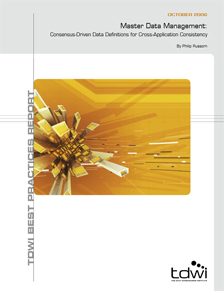
TDWI Best Practices Report | Master Data Management: Consensus-Driven Data Definitions for Cross-Application Consistency
October 23, 2006
Although MDM has long been done in a few isolated silo applications, companies now practice it in more silos and with more connections among silos. Forward-looking companies even practice enterprise MDM, with a broad scope across many applications and businesses. As with many data management practices, the general trend in MDM is toward broader and better integrated enterprise scope.
As an integration practice, MDM is late to the data integration frenzy of this decade, yet still part of it. For many technical users, MDM is an extension of other growing practices, like data integration, data warehousing, BI, data quality, and metadata management. In some cases, MDM’s central definitions are part of a general trend toward centralized IT.
MDM has business drivers, too. Post Enron and WorldCom, many corporations have entered an age of accountability, where executive actions are driven by audit paranoia, which MDM helps alleviate. Market consolidation is rampant in some industries (banking, high tech, telco), and MDM can be a useful component in the quick-but-critical integration of customers, financials, and products demanded of a merger, acquisition, or corporate re-org.
This report explores the many best practices—both business and IT—for MDM, describing common approaches, tool and technology use, economic issues, and user requirements.
Report Sponsors